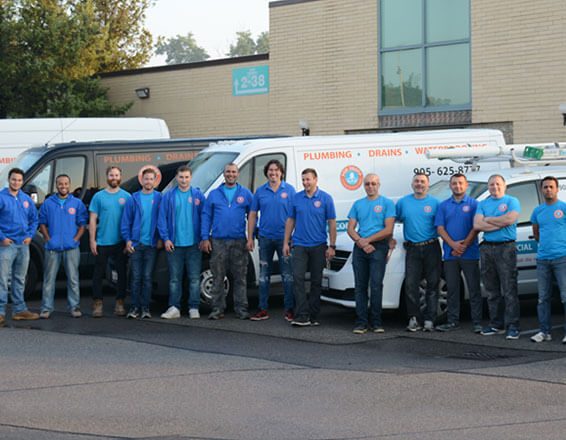How Does a Sump Pump Work?
The device has a hermetically sealed housing, which contains:
- An electric motor, which performs the duties of the power unit that starts the entire device in operation.
- Pump unit, which consists mainly of a disk with blades, which is an impeller.
- Additional equipment:
- Float, which is responsible for the device’s automatic start and stop;
- Thermoregulator, which protects the motor from overheating and automatically shuts down the motor when it reaches a critical temperature.
When you start the motor, the wheel works, creating pressure. Water enters a special chamber, pushing the pressure to the surface. The drainage basement sump pump system cannot cope with pumping the liquid to a great height, so it is used in places with a slight difference in levels. The device is covered with anti-corrosion protection and equipped with a special float that keeps it afloat. Some models also have a sensor that starts the motor when the water reaches a certain level.

Types of Sump Pumps
You can buy a sump pump in one of three types:
- Surface — designed for 8-9 meters of depth, it can cope even with silt impurities. It is simple to install and easy to maintain. However, its productivity is quite low, so this type is chosen to serve domestic premises and swimming pools.
- Semi-submersible — equipped with a special suction device immersed in water. The pump body is constantly on the surface.
- Submersible — a powerful and productive device, which is possible at a depth of up to 50-60 meters. Characterized by quiet operation, does not require installation work. It is used in boreholes and wells.
Basement sump pump systems can differ not only in the principle of operation but also in the material of manufacture: plastic, plastic and metal mechanisms, cast iron, and steel.
What Size Pump Do I Need?
The choice of pump should be based on the following characteristics:
- Power of the device
- Capacity (the number of litres of water the pump can pump in a certain time)
- Head (height of the liquid)
- Permissible size of impurities in the water
- Water temperature
- Maximum and minimum installation depth
When choosing a basement sump pump system, it is worth paying attention to the material of manufacture: the more durable the casing, the longer the pump will last.
Cost of a Sump Pump
Drainage pumps are in high demand, especially among those with country houses. Manufacturers offer a wide range of equipment designed to perform tasks that are different in complexity and scale of work. On store shelves, you can see both inexpensive proposals and serious devices at an impressive price.
Submersible, deep basement sump pump systems are considered one of the most expensive devices because they are characterized by serious technical characteristics and are made of durable, high-quality materials. The cheapest will be low-powered sump pumps designed to pump out small volumes of water without large impurities.

Factors That Impact The Cost Of A Sump Pump
- Power and capacity are the main factors that influence the cost of sump pumps.
- The manufacturer, the type of equipment, and the materials of manufacture of both the casing and the main working parts are also important considerations.
- Drainage basement sump pump systems from well-known brands differ not only in price but also in quality. Noname firms can also offer good options for equipment, but such products will require extreme attention when choosing. It is important to study the information about the materials and check the availability and terms of warranty on the sump pump.
How to Install a Sump Pump
Installing a sump pump will require the use of certain tools and construction equipment. However, performing all the work on their own will not be difficult if the user has the necessary knowledge, is familiarized in advance with the algorithm of the upcoming work, and is properly prepared for its implementation.
Digging A Sump Pit
If we are talking about the basement of the house, then it is necessary to remove the concrete where water most often accumulates before digging the well. The concrete is removed with an electric jackhammer or perforator. After the pieces of concrete are removed, you can start digging the well. The depth of the well should be 30 cm greater than the height of the pump sleeve.
Installing The Sump Pump
The sleeve is placed in the well. The space around it is filled with gravel and concreted to the level with the floor. After 8 hours, after the concrete has set, the work can be continued. First, a drainage pipe is installed on the sleeve, to which the basement sump pump system installed in the sleeve is connected. The drain pipe goes outside the house. It is unnecessary to lead it far beyond the wall, as a flexible hose will carry the water away from the foundation to a safe distance.
Completing the Discharge Pipe
A check valve needs to be installed on the outlet pipe. That will keep the water in the pipe after the pump stops. Most installations come complete with all the necessary parts, including connecting sleeves that indicate the direction of water flow.
Running Your Pump
Once the work has been completed, the basement sump pump system should be switched on and its operation checked. It is recommended that the well be filled with water to give an impression of real conditions and assess the equipment’s performance. During the test, special attention should be paid to the connections, the correct functioning of the valve, and the correct drainage to the specified location.
Are Sump Pumps Necessary?
Drainage pumps become almost indispensable for those who have a country house or a dacha plot. They help organize a proper water supply system in places where there is no central sewage system. In addition, drainage equipment is the first assistant in the case of a flooded basement.
Scope of application of the sump pump:
- Domestic — pumping water out of swimming pool wells, organizing an irrigation system, and water supply system.
- Industrial — assistance in irrigation of plots, pumping out sewage and process liquids.
- Construction — drainage of the basement, sewerage, excavation.
Considering the scope of the application and the work front, a certain type of drainage pump is selected.

Sump Pump Life Expectancy
The average life expectancy of a sump pump depends on factors such as workmanship, operating conditions, and intensity of use. Maintenance of the equipment becomes a mandatory part of its operation. It is recommended to regularly check the condition of the hoses, power cord, and housing. As clogging occurs, filters are changed, and the pump chamber is checked for blockages. Provided that the user follows the manufacturer’s recommendations for the use and care of the equipment, the basement sump pump system can last up to 15 years.
What To Do When Something Goes Wrong?
If the pump has stopped working properly, it is necessary to disassemble the casing, inspect the parts, find the cause of the fault, and repair it. The parts that can be easily replaced are the condenser, float, and impeller. Malfunctions can also occur due to a faulty cable or clogs formed inside the housing. It is easy for the user to get rid of sand and clay inside the equipment. To solve other issues, it is worth contacting the Masters of Service centers.
How Do I Know If I Need To Replace My Sump Pump?
Not all faults can be repaired, and some are not advisable from the point of view of financial and time costs. Breakdowns that you should consider fixing:
- The cast iron casing is deformed or cracked.
- The valve has failed.
- The winding no longer fulfills its duties.
- The stem has broken off.
Burned drainage pumps need to be more profitable to repair. Most often, service center masters do not accept hopeless devices at work.
Commonly Asked Questions
How do I calculate the capacity of the pump I need?
A drainage pump’s power depends on indicators such as volume and height of water level rise. If you cannot do the calculations independently, the best solution is to ask for help from someone who sells and installs the equipment.
Can I install the damp proofing system myself?
Yes, but you will need specialized tools and equipment for the job. Each damp proofing system comes with an instruction manual that provides detailed installation steps. If you lack the necessary strength, skills, or knowledge for a high-quality installation, it’s better to avoid the risk and call in professionals.
Is it necessary to maintain the damp proofing system?
Yes, regular maintenance is essential. Routine inspections ensure the system’s long-term reliability and effectiveness. Maintenance tasks for Exterior Damp Proofing include checking for leaks, ensuring proper drainage, and inspecting the integrity of any seals or barriers. Manufacturers typically provide guidelines in the user manual about how often maintenance should be carried out.
Can I repair the damp proofing system myself?
Minor repairs can be done on your own, provided you have the necessary skills, knowledge of how the system works, and the proper tools. However, serious damage or issues should be handled by professionals. Making mistakes during repairs without a complete understanding of the system can lead to permanent damage and increased costs down the line.
 CLOGGED OR BROKEN WEEPING TILE
CLOGGED OR BROKEN WEEPING TILE